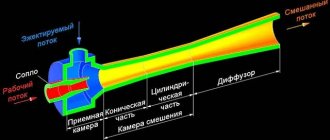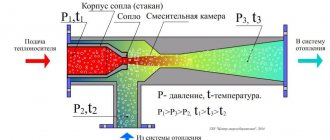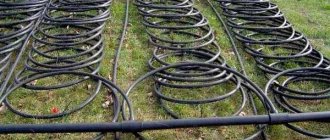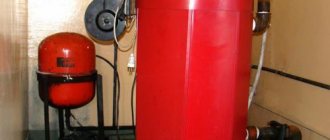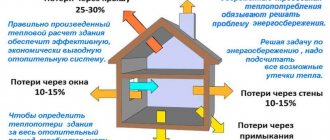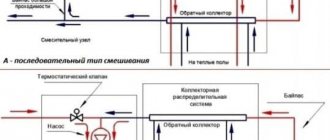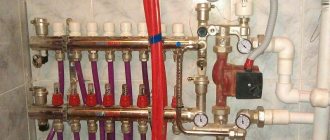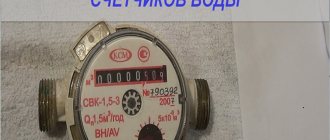Currently, for every resident of an apartment building, the issue of saving costs on housing and communal services is of fundamental importance. They can be reduced not only by systematically recording the amount of resources consumed, but also by choosing a property with modern utilities. A special device allows you to reduce energy consumption and at the same time ensure optimal temperature conditions in the room in winter. Let's consider what an individual heating point (IHP) is as the best option for saving utilities.
Main tasks of ITP
This is a modular installation that operates autonomously and transfers heat from the thermal power plant (boiler room) to the home heating system. In fact, the device performs a number of functions that significantly improve the quality of life in a high-rise building. To fully understand what an ITP is in an apartment building, you need to understand what this installation allows you to do. Namely:
- regulate the water temperature in the hot water system in autonomous mode, as well as in the heating system, taking into account the prescribed schedule;
- connect hot water supply and heating systems in the house to external communications;
- ensure protection of the heating system from pressure drops in the heating network.
Pumps, collectors, pipelines, instrumentation, thermostats are the main components of ITP.
Advantages of having an individual heating point
Modular installation provides residents with a whole arsenal of beneficial preferences. These include:
- autonomous operation mode (minimizing the number of service personnel);
- reduction in installation maintenance costs (from 40 to 60%);
- reduction in costs for heating energy (up to 30%);
- ease of installation;
- low noise level during operation;
- reduction of heat loss by up to 15% due to the absence of errors when setting up modes;
- the ability to attract workers with lower qualifications;
- improving the quality of the coolant.
Automatic ITP allows residents of apartment buildings not to worry about whether their apartments will have the optimal temperature during the heating season. However, installation of a modular installation will require significant investment, but after some time it will pay off due to savings in the supplied resource.
What functions does an individual heating unit perform?
Individual heating point in the basement of a building
One of the main functions of the ITP is the automatic regulation of heat flow, that is, adjusting the amount of hot coolant coming from the heating network to ensure a certain coolant temperature at the entrance to the heating system of the house, depending on the current outside air temperature. Weather-dependent regulation makes it possible to save the amount of consumed thermal energy. In other words, if it is warm outside, then the heat flow regulator in the individual heating point reduces the temperature of the coolant circulating in the heating system to ensure a comfortable air temperature in the heated rooms, and if it is cold, it increases it according to the specified settings.
The heating system heat flow regulator includes:
- an electronic regulator with connected temperature sensors (at a minimum - the outside air and the temperature of the coolant entering the heating system), which controls;
- an electrically driven control valve to provide the required amount of heating fluid from the heating network, which enters the internal heating system to compensate for heat loss in the building depending on the outside temperature.
All this equipment must operate exclusively in automatic mode, so the correct adjustment of the entire complex of equipment for work in a particular home is critically important.
Depending on the configuration, the ITP can control the heating system or hot water supply system in the house, as well as control both systems simultaneously.
If the ITP is installed only to control the heating system of the house, then the list of its main equipment includes a control valve with an electric drive, an electronic temperature controller with weather control with temperature sensors, an automatic differential pressure controller, two circulation pumps and corresponding shut-off valves.
As part of the ITP, which also controls the hot water supply system of the house, first of all, a heat exchanger is needed, in which, in fact, the water from the water supply is heated to the required temperature, as well as a control valve with an electric drive, which is controlled by an electronic temperature controller or an automatic direct-acting temperature controller, and also an automatic differential pressure regulator and two circulation pumps.
In addition, the ITP package may include additional pumps for pumping, for example, cold water, and additional automatic coolant pressure regulators.
What types are there?
The ITP classification is based on criteria that determine the characteristics, layout, purpose, and method of installation of a modular installation. A central heating point is an installation whose operation extends to several real estate objects. As a rule, it is installed in a basement or separate room. There are also:
- individual TP (serves one building or part of it);
- block TP (supplied assembled, compact, simplifies the process of updating utilities).
Heating units also vary in power: small (up to 40 kW), medium (from 40 to 50 kW), large (from 50 kW to 2 MW).
Features of work
Initially, cold water enters the ITP from the central water supply system. The liquid is then divided into three streams:
- arrives to apartments in a cold state.
- is heated and enters the living quarters.
- closed loop/heating system (heat is supplied to the apartments through pumps, some of which is lost during the circulation period).
With the help of IHP, an apartment building is provided with heat around the clock, and its consumption is paid for according to the IPU. Cold water in a modular installation is heated by a heat exchanger. After the temperature rises, it enters the MKD heating system and the hot water supply network through pumps. To ensure maximum performance of the device, it is necessary to carry out timely maintenance of the ITP. The latter can be carried out at different frequencies (unscheduled, once a week/month/year) depending on the specifics of the work.
How does an elevator unit work?
Before understanding the structure of the elevator unit, we note that this mechanism is intended to connect end-users of heat to heating networks. By design, the thermal elevator unit is a kind of pump that is included in the heating system along with shut-off elements and pressure meters.
The elevator heating unit performs several functions. First of all, it redistributes the pressure inside the heating system so that water is supplied to the end consumers in the radiators at the specified temperature. When passing through pipelines from the boiler room to apartments, the amount of coolant in the circuit almost doubles. This is only possible if there is a supply of water in a separate sealed container.
As a rule, coolant is supplied from the boiler room, the temperature of which reaches 105-150 ℃. Such high rates are unacceptable for domestic purposes from a safety point of view. According to regulatory documents, the maximum water temperature in the circuit cannot exceed 95 ℃.
It is noteworthy that SanPin currently sets the coolant temperature standard within 60 ℃. However, in order to save resources, a proposal to reduce this standard to 50 ℃ is being actively discussed. According to an expert opinion, the difference will not be noticeable to the consumer, and in order to disinfect the coolant, it will need to be heated to 70 ℃ every day. However, these changes to SanPin have not yet been adopted, since there is no clear opinion about the rationality and effectiveness of such a decision.
The diagram of the elevator heating unit allows you to bring the temperature of the coolant in the system to standard values.
This node allows you to avoid the following consequences:
- Batteries that are too hot can cause skin burns if handled carelessly;
- not all heating pipes are designed for prolonged exposure to high temperatures under pressure - such extreme conditions can lead to premature failure;
- if the wiring is made of metal-plastic or polypropylene pipes, it is not designed for the circulation of hot coolant.
ITP for different purposes of use
Being a modular installation, the heating unit is equipped with an independent circuit in which a heat exchanger is mounted, made on the basis of graphite, copper or steel plates (load - 100%). The optimal pressure is maintained by a dual pump. Make-up is provided in heating networks. Additional components of the ITP of an independent circuit are a hot water supply unit and metering devices.
There are heating units specifically installed for hot water supply. They operate according to a single-stage scheme, which includes 2 devices, the load on which is distributed in a percentage ratio of 50/50. The installation is equipped with PU and pumps that prevent pressure loss.
A heat exchanger with a 100% load is also used for ventilation. The increase in liquid temperature is ensured by 2 devices with the same power (50/50). A closed DHW system allows the liquid coming from the water supply to be heated in a network heat exchanger. In open ones, hot water is drawn directly from the heating network.
Scheme
A significant part of apartment buildings provide a closed hot water system. Hot water supply and heating are separate circuits through which coolant is supplied using pumps. The ITP circuit diagram significantly minimizes resource leakage, which makes it possible to reduce the volume of its consumption.
Types of IPT by type of thermal energy consumption systems
Systems can be used standard, or combined. Thus, the classic options for selecting heat supply systems consist of the following configuration for the general ITP scheme:
- Heating function.
- Hot water supply.
- Combination of two functions - heating and hot water supply (DHW).
- Combination of hot water supply and warm ventilation.
| Focus of ITP | System Description | Additionally |
| Heating only | Scheme type – independent: — plate heat exchanger with 100% load; — double pump; — power supply from the return pipeline of the heating network. | — hot water block; — metering devices and other components. |
| DHW | Circuit type – parallel, single-stage: — heat exchanger – 2 pcs. 50% load, plate; — a group of pumping units. | — heating unit; - accounting devices, etc. |
| Heating + hot water | Type of heating circuit - independent, for hot water supply - independent, two-stage: — plate heat exchanger with 100% load; — groups of pumps; — power supply from the return pipeline of the heating network by a pump; — metering device; — plate heat exchanger 2 (for hot water supply); — power supply from cold water supply (for DHW). | At the request of the customer |
| Heating + DHW + Ventilation | Independent circuits, DHW - independent and parallel, 1-stage: — for ventilation, a plate heat exchanger with a load of 100% is built in; — for hot water supply – 2 plate heat exchangers, 50% load each; — group of pumping units; — feeding – return pipeline and cold water for DHW. | Metering devices |
Installation procedure
Before installing the heating unit, a number of preparatory actions must be carried out:
- a positive decision made at a general meeting of owners (tenants of the house);
- contacting a resource supplying organization with an order for the preparation of technical specifications by specialists, and receiving it;
- initiation of a design survey (to determine the condition and list of previously installed units);
- creation (in a specialized company with a license) and approval of the corresponding project;
- conclusion of a contract.
Only after these steps can you begin to install the modular installation and carry out commissioning of the ITP. They should be handled by an organization that has experience and the right to carry out such work.
Operation of an automated individual heating point in an apartment building
ITP is the link between the thermal power plant (boiler house) and each apartment in the apartment building. As a result, residents are provided with heat and hot water. Moreover, the modular installation operates thanks to its connection to heating networks. ITP makes it possible to pay less for the supplied resources, but the amount of savings depends on the degree of load and operating mode of the device. These factors must be taken into account in the design documentation, otherwise an individual heating point in an apartment building may not provide the expected reduction in costs for housing and communal services.
Operational safety
Only persons with a sufficient level of qualification are involved in servicing the heating unit. The latter must have an impeccable knowledge of the operating rules of the ITP and be able to apply them in practice. It is also important to observe safety precautions when handling a modular unit. In particular:
- it is necessary to systematically analyze the inlet and outlet pressure indicators;
- it is prohibited to operate pumps in the absence of water;
- you should respond to extraneous noise/vibration and motor overheating when working with units;
- Do not disassemble regulators while the system is under pressure.
The above list is not exhaustive.
Preparation of necessary documentation
For legal installation of ITP, it is necessary to submit a certain list of papers to Rostechnadzor employees. These include:
- project;
- THAT;
- a document confirming connection to the networks of the resource supplying organization;
- heating point passport;
- acts of completed work;
- heat supply agreement;
- certificates proving the quality of equipment and components;
- an order appointing a person responsible for maintaining the modular installation;
- job descriptions of those specialists who will ensure the operation and safety of the equipment.
At the final stage, logs are created in which clearance orders, defects, etc. are recorded. Individuals familiar with safety precautions when working with ITP are indicated in a separate one.
